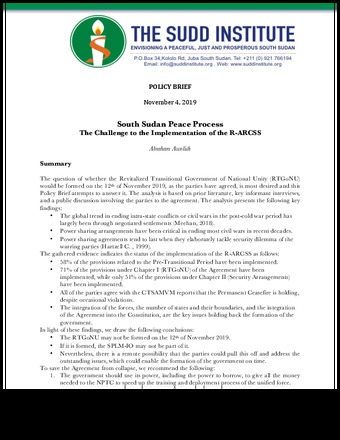South Sudan Peace Process: The Challenge to the Implementation of the R-ARCSS
Publication Summary
The question of whether the Revitalized Transitional Government of National Unity (RTGoNU) would be formed on the 12th of November 2019, as the parties have agreed, is most desired and this Policy Brief attempts to answer it. The analysis is based on prior literature, key informant interviews, and a public discussion involving the parties to the agreement. The analysis presents the following key findings:
- The global trend in ending intra-state conflicts or civil wars in the post-cold war period has largely been through negotiated settlements (Meehan, 2018).
- Power sharing arrangements have been critical in ending most civil wars in recent decades.
- Power sharing agreements tend to last when they elaborately tackle security dilemma of the warring parties (Hartzell C. , 1999).
The gathered evidence indicates the status of the implementation of the R-ARCSS as follows:
- 58% of the provisions related to the Pre-Transitional Period have been implemented.
- 71% of the provisions under Chapter I (RTGoNU) of the Agreement have been implemented, while only 51% of the provisions under Chapter II (Security Arrangements) have been implemented.
- All of the parties agree with the CTSAMVM reports that the Permanent Ceasefire is holding, despite occasional violations.
- The integration of the forces, the number of states and their boundaries, and the integration of the Agreement into the Constitution, are the key issues holding back the formation of the government.
In light of these findings, we draw the following conclusions:
- The RTGoNU may not be formed on the 12th of November 2019.
- If it is formed, the SPLM-IO may not be part of it.
- Nevertheless, there is a remote possibility that the parties could pull this off and address the outstanding issues, which could enable the formation of the government on time.
To save the Agreement from collapse, we recommend the following:
- The government should use its power, including the power to borrow, to give all the money needed to the NPTC to speed up the training and deployment process of the unified force.
- The SPLM-IO, particularly Dr. Riek Machar, should move to Juba to allow for sustained interactions with the President in order to speedily overcome the remaining issues.
- The IGAD, through the Regional Protection Force, should provide provisional security to Dr. Machar while in Juba until the unified army is deployed, including the VIP protection force.
- If the parties cannot adopt the recommendation of the IBC, they should defer the decision on the number of states and their boundaries to the constitutional-making stage, benefiting as well from the Resolutions of the National Dialogue.
- The International Community, especially the Troika, African Union, UN Security Council, and the IGAD should support the parties to overcome the remaining hurdles to the formation of the RTGoNU by providing both material support and maximum pressure.
Abraham Awolich is the former Managing Director of the Sudd Institute. Awolich’s research has focused on management of development organizations working in conflict mitigation, governance and business management. Awolich is the co-founder of the Sudan Development Foundation and the former Executive Director of New Sudan Education Initiative (NESEI). Previous to joining the Sudd Institute, Awolich helped establish a secondary school in Yei and a medical clinic in Kalthok, Awerial County. Awolich has a Master’s Degree in Pubic Administration from the Maxwell School of Citizenship and Public Affairs at Syracuse University and Bachelor’s Degree from the University of Vermont in Anthropology and Business Administration. Awolich is a McNair Scholar and winner of the prestigious Samuel Huntington Public Service Award in 2006.

